Introduction
Konkan is that narrow and spectacular strip of land encompassing coastlines, estuaries, lateritic plateaus, foothills of Western Ghats and dense forests, which runs from Maharashtra to Goa. Bound by the Arabian Sea to its west and the mighty Sahyadri ranges (Western Ghats) to its east, the region has a distinct and rich culture of folklore, performing arts, music, literature, culinary art. Konkan, its temples, rivers and forests have an entire Sahyadrikand of the SkandPurana dedicated to it. Several poems and songs have been penned about the beauty, the mystery and the people of this region. Many of our celebrated singers, poets and authors come from Konkan. Community conservation practices that thrive here include some of the most pristine Sacred Groves, Temple Tanks, Fish Sanctuaries and sacred trees.
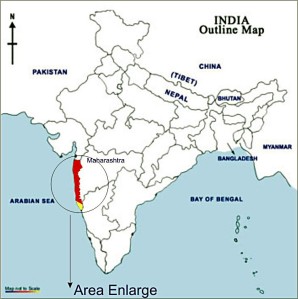 Left: Index Map of Konkan (in red) From: KonkanTrips
Left: Index Map of Konkan (in red) From: KonkanTrips
Konkan of Maharashtra, the subject matter of this report, consists of Greater Mumbai, Thane, Raigad, Ratnagiri and Sindhudurg Districts, covering an area of 30,394 sq kms and running for about 720 kms. Of the 17,000 square kilometers area of Maharashtra Western Ghats, identified as ‘Eco Sensitive’ according to High Level Working Group Report on Western Ghats, majority falls in Konkan Division.
Konkan has a unique physiography with an undulating terrain and narrow coastal plains. It receives heavy rainfall from South West monsoons averaging to about 3000 mm. Elevation difference for a small width of about 50-60 kms ranges from mean sea level to over 1000 meters. Due to severe slopes, the drainage pattern is dense and dendritic, leading to poor groundwater recharge on slopes but good recharge in plains and valleys. Geological strata is composed of rocky basalt, lateritic plateaus, sandy coasts and small alluvial river mouths and valleys.
Konkan holds 22 river basins. All rivers that flow here originate in the Western Ghats and are swift and west flowing, with narrow, rocky basins, smaller catchments, shorter lengths and smaller estuaries as compared to their east flowing counterparts also originating from Sahaydris like Krishna and Godavari. Damanganga, Ulhas, Vaitarna, Savitri, Shastri, Gad, Karli, Terekhol etc., are some of the important rivers of Konkan. They are marked by rich biodiversity, dense forests and productive estuaries and they play an integral part in the social and cultural lives of the Konkanis.
Traditional water systems here revolve around groundwater from lateritic plateaus, hills streams and rivers. Due to quick runoff, swift, overflowing rivers of the monsoon dry up in the summer; range of groundwater fluctuation is also high. The region has several evolved traditional practices to utilize rainwater for irrigation and domestic use. The system of making “Paats” or irrigation channels off-taking from rivers, hills streams and groundwater zones exists till date.
As a result of its singular soil-rainfall-topography, agriculture in Konkan is different from the rest of Maharashtra. Traditional crops include paddy cultivated on terraces and millets like Ragi cultivated on slopes. Mainstay of agricultural economy is horticulture of Mango, Cashewnuts and kokam (Garcinia fruit). These have no specific irrigation needs and grow on slopes. Coconut and Arecanut plantations on the precious strips of plain land require water. In Rabi, region-specific pulses are grown on soil moisture and dew. Due to poor soils and hot weather, the region is not a leader in spices, coffee, tea or rubber. Migration from Konkan to Mumbai and other parts of the state has always been high and farm labour is difficult to find.
Due to several factors like a rugged undulating terrain, lateritic porous strata, poor soil, traditional crops which do not need irrigation, etc. Major Irrigation Projects and dams are rare in Konkan. This is despite the fact that Konkan gets 45% of the average annual yield of all rivers in the state! It is here that you find one of the oldest earthen dams in the state: the Dhamapur Dam in Sindhudurg, which still stands proud, not only irrigating plantations but providing drinking water to the entire Malvan city. Temple Tanks in Sindhudurg provide drinking water, irrigation and recharge groundwater.
Following the surge of dams in Maharashtra, several major and medium irrigation projects, drinking water supply and hydropower projects were proposed and developed in Konkan.
A reconnaissance of the current situation is disturbing. It indicates that despite spending more than Rs 6,000 Crores in building these dams for decades, not a single Major or Medium irrigation project has been completed in Konkan till date by Konkan Irrigation Development Corporation (KIDC). Actual Irrigation Potential created is less than 25%, of which less than one percent is actually used by people for irrigation, for projects tested by CAG[i]. Hydropower generation from projects is shockingly low.
But for building these non-performing dams, not only have we spent thousands of crores of tax-payers money, we have displaced thousands of people, affected ways of life, desecrated sacred conservation areas, deforested thousands of hectares of forests in Western Ghats, destroyed habitats of wildlife, affected migration routes of Elephants, Tigers and Fish. The sum of these impacts maybe more tragic as compared to monetary corruption alone.
Currently, 12 irrigation projects of KIDC[ii] in Thane, Raigad and Ratnagiri Districts of Kokan, undertaken by FA Constructions and FA Enterprises are facing enquiry by the Anti-Corruption Bureau[iii] for severe corruption charges. Water Resource Minister Girish Mahajan has indicated that a charge-sheet will be filed shortly in which former Deputy CM Ajit Pawar and Former Water Resource Minister Sunil Tatkare may also be named [iv]. Stories of corruption in KIDC are varied and amusing. According to some, when Talamba Major Irrigation Project was being sanctioned, a Sumo full of cash was given as a bribe to one of the leading politicians of Konkan, who kept the money…and the Sumo as well.
Several of KIDC Irrigation projects have violated Environmental Laws and Project Affected People of almost all projects are protesting due to insufficient compensation and shoddy rehabilitation. Man-Animal Conflicts are not rare in regions where dams blocked migration routes.
This state of things requires a fundamental rethink.
When I asked a farmer in Ratnagiri about Major and Medium Irrigation Projects in Konkan and if they have helped, he says “Whom have these projects helped? Not us!”. A Geologist says, “Large dams in Konkan are not viable on multiple scales” . An Agricultural Scientist says, “Engineers from Western Maharashtra posted in Konkan have their own ideas for irrigation which suit Western Maharashtra, not Konkan. They have not worked and will not work here.” Former Head of Walmi who has also worked in Konkan as an Engineer says, “Large dams in Konkan are a reflection of Intellectual Corruption in WRD and a resolute denial to learn lessons from past mistakes. I think the area irrigated by Major and Medium Projects may be less than the land submerged behind them”. However, when I ask the same question to a senior official of the Konkan Irrigation Development Corporation (KIDC) he says despondently: “It is Government Policy.”
This blind push for large dams has resulted in social, economic and ecological losses, without any substantial gains
 Farmer lifts water from Shastri River with traditional device called Ukti (Photo: by Author)
Farmer lifts water from Shastri River with traditional device called Ukti (Photo: by Author)
Farmers in Konkan need protective irrigation, but their needs are very different from the Plateau. There is an urgent need to take an objective look at the approach of pushing large projects as a matter for policy for a region that does not need or want them. A thorough audit of Irrigation Projects in Konkan needs to be undertaken with a scope that is wider than regular CAG Reports. Projects like Talamba Major Irrigation Project, which have been lying idle for several years, have been rejected permissions, face strong local opposition, are unviable and would need massive amounts of additional funding, need to be scrapped to stem the flow of tax payers money down a blackhole.
Rather than spending further crores, benefiting the contractors and continuing questionable projects, perhaps there is need to acknowledge that past experience of pushing large dams in Konkan is a lost cause.
While this may sound difficult to achieve, we hope that the following sections make its need self evident. The balance cost of main projects now stands at about 11,000 Crores and will only increase with time. In this context, schemes like current government’s flagship Jalyukta Shivar are ideally suited for Konkan and require a major fillip.

Above: Karli River in Sindhudurg (Photo: By Author)
Konkan Irrigation Development Corporation and the damming of Western Ghats
White Paper on Irrigation Projects published by Government of Maharashtra in 2012 lists 4 major projects, 11 medium projects and 4 projects under BOT (Build-Own-Transfer) by KIDC (which are all Drinking Water Dams for Mumbai). It has avoided mentioning several of the more problematic projects. However, NONE of the irrigation projects mentioned in the White Paper have been completed till date, even after 33 years of starting work for some. In some cases, the scope has been changed from Irrigation to Drinking Water and the irrigation component has been put on a back burner. (Details of some projects in Annex 1)
Konkan Irrigation Development Corporation (KIDC) was formed in 1998 under KIDC Act 1997 to expedite irrigation projects in Konkan administrative division and also independently raise capital from the market for this purpose. Of the cultivable command of 15.68 Lakh ha in the region, estimated irrigation potential that can be developed is about 3.67 L ha. But according to CAG Report 2010[v], of the 90 projects handed to KIDC in 1998, only 13 were “partially complete” in 2010. Although KIDC is supposedly autonomous, “All planning, approval, tendering, allocation of funds was done by the government and not KIDC”.
- From the CAG Report, 2010
After spending Rs 4363 crores on 90 projects since 1990, only 13 could be partially completed till 2010. Recommendation of HPC (High Powered Committee) about prioritizing projects where over 75% work has been completed was ignored by KIDC leading to too many incomplete projects, no budget and no rise in Irrigation Potential. KIDC violated laid down norms of not taking up projects unless all land required has been acquired, Forest Clearance has been granted and PAPs (Project Affected Persons) have been rehabilitated. Starting projects in the absence of these statutory requirements has led to a situation where projects are stalled, land acquisition could not be completed, there was no money to resettle the PAPs, and contractors had to be paid idle charges. For 16 projects checked by CAG in 2010, work orders were issued by KIDC before acquiring lands and all of these 16 were stalled by PAPs. KIDC did not even let the Special Land Acquisition Officer (SLAO) know of the complete land requirement for these projects.
In case of Nardave Medium Project in Sindhudurg, for which the KIDC still does not have Forest Clearance, KIDC paid Rs 7.4 Crores to contractor as idle charges, but did not pay Rs 3.1 Crores to Forest Department as NPV (Net Present Value of the forestland). There are several examples where the KIDC did not pay the full compensation amount to the PAPs, neither did it deposit the full amount with the SLAO. The CAG report seethingly notes that while KIDC was short of money to pay the PAPs who were losing their homes and fields, it paid advances to contractors even when it was prohibited by the Maharashtra Public Works Manual. In case of Deharji Medium Project, Rs 10 Crores were paid as advance in 2007 to an influential contractor, but the dam work did not start in the absence of FC till 2010. For these 3 years, no substantial recovery of advance was made when there was no work done!
Of 30 projects test checked by CAG, 10 were under repairs for more than 5 years, necessitating no irrigation.
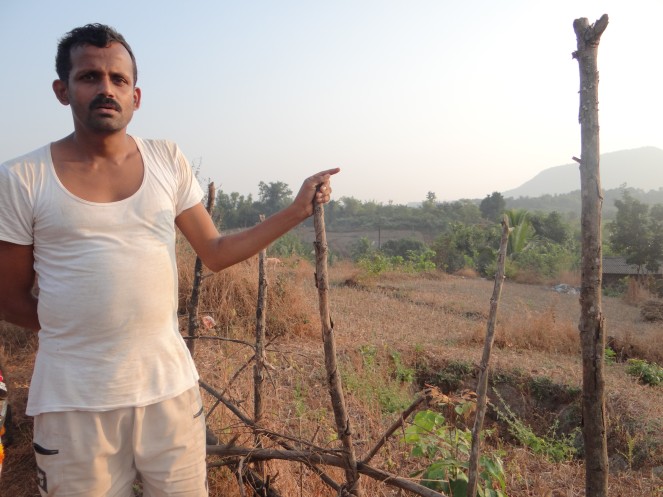
Project affected by Tillari Interstate project, in incomplete rehabilitation village (Photo: by Author)
Damningly, CAG says that although heights of dams was increased, none are complete, nor did increase in height lead to increased storage. The Executive Director of KIDC justified this by stating that heights were raised to store more water and irrigate more area. The hollowness of this claim is clear we consider Land acquisition problems, lack of clearances and of funds. For 38 projects on which Rs 800 Crores have been spent and which have been going on for upto 20 years, no storage has been created.
- CAG Report 2013-14[vi]
The Report states that of the 64 ongoing projects of KIDC as of 2013, total expenditure has been Rs 6020 Corers and the updated cost of ongoing projects is more than Rs 11,000 Crores.
Of the 64 ongoing projects, 54 projects have seen massive cost escalations. When Administrative Approval was given for Rs 783 Crores, expense has been Rs 6020 Crores. In 2013, 25 of KIDC projects needed a whopping 6303 ha of Western Ghats Forest lands and many had proceeded without securing statutory Forest Clearance, a punishable offence.
This CAG report was played down by the government when a PIL against multiple irregularities in KIDC was filed in the Bombay High Court in 2013. However, CAG through an affidavit stood firm by its report.[vii]

Tillari Interstate Project Sindhudurg (Photo: by Author)
3. Snapshot of some KIDC dams in Western Ghats
SANDRP has visited several projects undertaken by KIDC, has talked with the Project affected people, as well as Engineers and officials. The picture which emerges is sordid. Some of the notable projects are mentioned below:
a. Talamba Major Irrigation Project, Kudal, Sindhudurg
Talamba Major Irrigation project was planned across River Karli in Kudal Taluka of Sindhudurg 34 years ago. For a Project which received Administrative Clearance and funds in 1981 and for which Rs 142 Crores have been spent till date, it is not even 20% complete. The project aims to irrigate 28,900 ha and has a submergence area of 2618 ha, including 626 ha of Forest Land in Eco Sensitive Area. Work on Talamba Major Project started without Forest Clearance (FC) and it still does not have final Forest Clearance! In fact, the State Forest Division has rejected its FC application in 2015. Government continues with the project doggedly which now costs an estimated Rs 1,772 Crores.
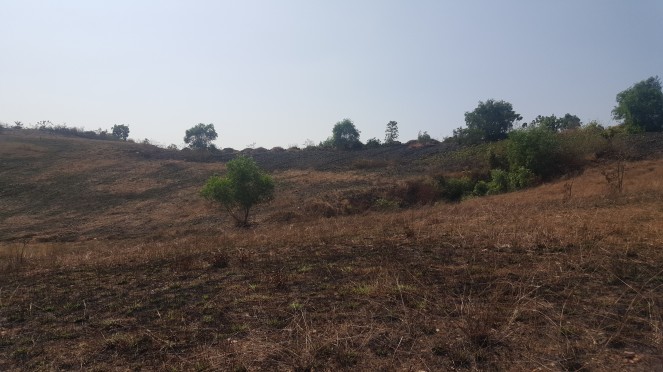
Bal Sawant, who has been leading the struggle on this dam in the region tells me that the government “better scrap” the project urgently, which will displace over 5000 people in 7 villages. “The dam officials are raking salaries for doing no work for decades. The command of the project actually includes about 5000 ha of Forest Land. The command also overlaps with other irrigation projects like Sarambala. What irrigation are we then talking about? Large parts of the command[viii] is already served better functioning by Minor Irrigation Projects and tanks. There are several sites where smaller projects can be built, without displacing people. We will continue to fight. You see, even after 34 years of starting a project the government could not rehabilitate affected people or compensate all of the affected population. How can we trust them?”
When I visited the dam site in January 2016, all that could be seen of the dam was a partly made stone-pitched dam wall. Forests in the submergence area are some of the most luxuriant forest I’ve seen in Western Ghats of Maharashtra. According to Sawant, when the project received Environmental Clearance in 2001, villagers did not receive a notice of Public Hearing in Marathi, neither was the EIA translated in Marathi and given to people. PAPs have stalled dam work more than 4 times in the past, but still rehabilitation and compensation is incomplete.

Talamba Major Irrigation Project has been in limbo for more than 34 years due to inefficiency, lack of will to solve PAP issues, absence of Forest Clearance and violations. It does not have an Investment Clearance from the CWC (Central Water Commission). The submergence area lies in the Eco-sensitive Area of the Western Ghats as per the High Level Working Group on Western Ghats Report (HLWG Report).
Action needs to be taken against responsible officials for starting work without Forest Clearance and rehabilitation of PAPs. The affected people themselves have drawn out plans where KT weirs on Karli River can provide effective and cheaper irrigation for part of the command than spending 11,000 Crores or more. When I discussed the project with senior official in KIDC, he simply said, “Forest Department should give clearance and project affected should take back their struggle.”
b. Virdi Large Minor Project, Sindhudurg
When I visited the strangely-named Virdi “Large Minor” Project in Jan 2016, several Trucks, JCBs and machines were languishing at the dam site. The Dam itself, a huge structure, seemed almost complete, without the main river plugging. Hills in the upstream were deforested and made into pineapple and rubber plantations by, I was told, rich lobbies from Kerala who are eyeing backwater irrigation once the dam is complete. This project, which is at the head stream (Walvanti) of the Mhadei River, has been asked to stop work by the Mhadei Water Dsiputes Tribunal in 2015. Mhadei is a shared basin between Goa, Maharashtra and Karnataka and the river is the lifeline of Goa. Maharashtra has agreed to maintain status quo on the work through an affidavit[ix]
 Virdi Dam Wall. Only River plugging remains (Photo: by Author)
Virdi Dam Wall. Only River plugging remains (Photo: by Author)
The project does not have an Environmental Clearance, nor does it have Wildlife Clearance, although it is barely 3 kilometers from Mhadei Wildlife Sanctuary in Goa. In August 2015, Union Water Resources Minister Uma Bharti stated before the Parliament that “Maharashtra government did not secure environmental clearances for the Virdi dam on the pretext that the culturable command area (CCA) of the project is less than 2000 ha, requiring no environmental clearances.” However, according to government WRD Website itself, the project has a command of 2937 ha[x].
When I discussed this project with the officials, I was told that it was important to boost storages in Maharashtra and Virdi Dam water will augment Tillari Major Irrigation Project’s irrigated area, which is adjacent to Virdi Dam. Looking at the pathetic state of completion of projects in Konkan and dismal performance of Tillari’s distribution network, this sort of undertaking violating multiple laws should be unacceptable. We have spent Rs 58 Crores of this project whose costs stands at Rs 182 Crores as of March 2015.
c. Sarambala Medium Irrigation Project, Sindhudurg
When I visited Sarambala Dam site in the heart of Western Ghat forests, I was taken to the Durga Devi Temple and sacred grove in Dabhil, which will submerge under the dam. The villagers asked the Goddess to protect their village from drowning. And the Goddess herself, I thought.
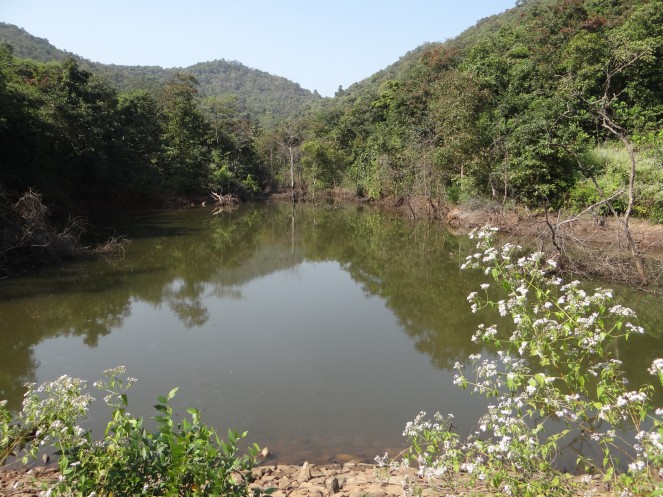 Rainwater harvesting structure made by villagers in Dabhil which will be submerged by Sarambala Project (Photo: by Author)
Rainwater harvesting structure made by villagers in Dabhil which will be submerged by Sarambala Project (Photo: by Author)
Sarambala Medium Irrigation Project falls in Sindhudurg in a region that is extremely rich in biodiversity. A voluntary organisation, Vanashakti, found out under the RTI Act that the villagers in the supposed command of Sarambala had never demanded for irrigation! While WRD claims that 22 villages will benefit from the dam, there are only 15 villages in the command, of which seven are already shown in the command area of the Tillari and Talamba irrigation projects!
The region is a part of the 35 km-long and 10 km-wide Sawantwadi-Dodamarg wildlife corridor, connecting the Koyna, Radhanagri and Chandoli Protected Areas in Maharashtra with Mhadei, Bondla, Bhagwan Mahavir, Netravali, Cotigao and Molem in Goa, and Anshi and Dandeli in Karnataka. This strip of land has over 303 species of plants, several with crucial medicinal values and 18 species of mammals, including tigers, leopards, bears and several species of birds. It is also an elephant corridor. Nevertheless, KIDC claims this region has no wildlife while the Forest Department claims that there are no religious, cultural or archaeological sites here. The EIA of the project has not been made public.
Though the project is yet to receive environmental clearance and a final forest clearance, KIDC issued a work order in 2005. Neither community and individual forest rights as per the Forest Rights Act, 2006 have been settled nor have rehabilitation proposals been prepared. The White Paper has pushed the project claiming that it has spent over 25 per cent of its budget and 35 per cent work has been completed.
While showing a percolation tank built by the villagers, leader of the dam resistance Balkrishna Gawas asks me, “This region receives 4,000 mm rainfall. If we villagers can build water harvesting structures for our water security at a fraction of the dam’s cost and with so little ecological impacts, can’t the Water Resources Department do so? Is drowning forests and our villages the only way forward they know?”
Similar is case of Nardave Medium Project where work was started without Forest or Environmental Clearance as well as Shirshinge and Deharji Medium Projects.
d. Kal-Kumbhe Hydropower project, Mahad, Raigad
Kal Kumbhe Hydropower Project is an example of an entirely unviable project. This Small 15 MW +10 MW hydropower project includes two dams in Western Ghats, one of them over 55 meters high and two massive tunnels, submerging 6 villages and displacing more than 1500 people. The total expense now is more than Rs 300 Crores, and the expenditure lies locked for 4 years as the work has stopped due to protests from people who were not rehabilitated and absence of Forest Clearance.
 Vardayini Fish Sanctuary on Kal River which will be rendered dry by Kal Kumbhe Project (Photo: Author)
Vardayini Fish Sanctuary on Kal River which will be rendered dry by Kal Kumbhe Project (Photo: Author)
When the average per MW cost for small hydropower project is about 8-9 Crores as per the Union Ministry of New and Renewable Energy (MNRE), the cost for Kal Kumbhe project will be a minimum of Rs 25 Crores /MW, mostly more than that. This is discounting the cost of rehabilitation, impact on biodiversity and Forests. All submergence area lies in Eco Sensitive Area of the HLWG. I had stumbled upon the dam site accidentally, when I was visiting a community conserved fish sanctuary just downstream the dam site. The sanctuary, protecting endangered Mahseer fish, will be rendered dry and lifeless if the dam materializes.
Similarly, Government of Maharashtra is claiming that there is insufficient water for 60 MW Tillari Main Dam in Sindhudurg to generate power and is pushing for Tillari Stage II Project[xi] which includes 3 more dams in the upstream which will require 642 ha additional land, including about 550 ha of Forest Land in Eco Sensitive Area and an Elephant Corridor. Effectively, this means much more than 700 ha of land to generate only 60 MW of power and 11.66 ha of forest for 1 MW of power! For 1 MW power generated by Solar, only about 2 ha land is needed. Even if we do not include the value of forests, this project is entirely unviable.
Apart from Environmental Impacts and violations, none of the large dam projects in Konkan can claim satisfactory rehabilitation of Project Affected People before starting dam work, as is mandatory. Riverside lands which are richly irrigated and covered with plantations are being submerged under these projects, which remain incomplete and do not deliver a fraction of benefits promised. The case of Jamada Medium Irrigation Project in Rajapur Taluka of Ratnagiri is stark in this regard. No Irrigation potential has been created for Jamada Dam in 10 years since the work started. More than 3000 people have been affected. Even joint surveys of their lands have not been completed till dated. Of the 733 ha required for the project, only 44 ha have been acquired so far[xii] but expenditure is already more than Rs 300 Crores! Same is the case with Arjuna, Devghar and Gadnadi Medium Projects (Refer to Annex 1).
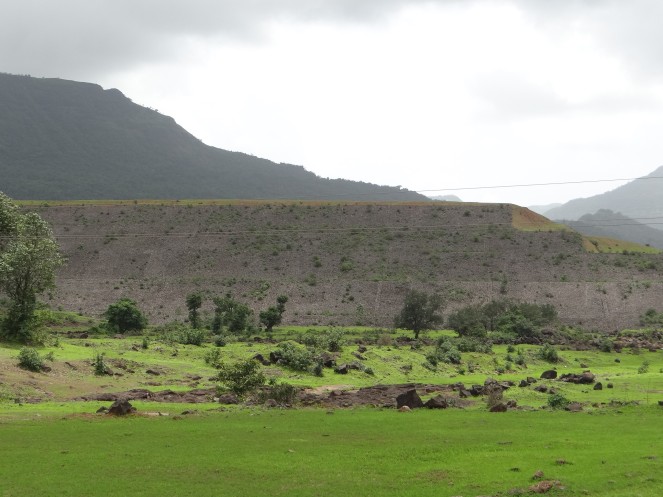 Massive 55 meters High Kal Dam for generating mere 15 MW Power (Photo: Author)
Massive 55 meters High Kal Dam for generating mere 15 MW Power (Photo: Author)
What Experts and Stakeholders Say
When I discussed Large Dams in Konkan with water experts and people working in the region, their verdict seems clear.
Satish Bhingare, Former Director General WALMI Aurangabad, Government of Maharashtra states that large dams in Konkan; constructed for irrigation; are a big mess and a symbol of not only monetary, but Intellectual Corruption.
He says, “Irrigation in Konkan is different from the rest of the state. Horticultural crops, the mainstay of Konkan agro-economy do not grow on extensive plains, but on hills where the exercise of irrigation through extensive canal network has been a catastrophe. They are irrigated by groundwater and hill streams (Parhye or Pat in Marathi). Resultantly, the region does not have an irrigation culture like say Western Maharashtra. Lateritic, light soil cannot provide an ambiance conducive to operating typical open canal network on the other hand; water logging causes massive crop losses like Kal Amba Irrigation Project in Mangaon. I doubt if Large dams in Konkan are providing even as much irrigation as the area they submerge. Small projects built at 100% dependability backed by a closed conduit distribution network suits the region the best. KIDC needs to look back and think about the Lessons Learned from the past. Unfortunately, such reconnaissance rarely happens.”
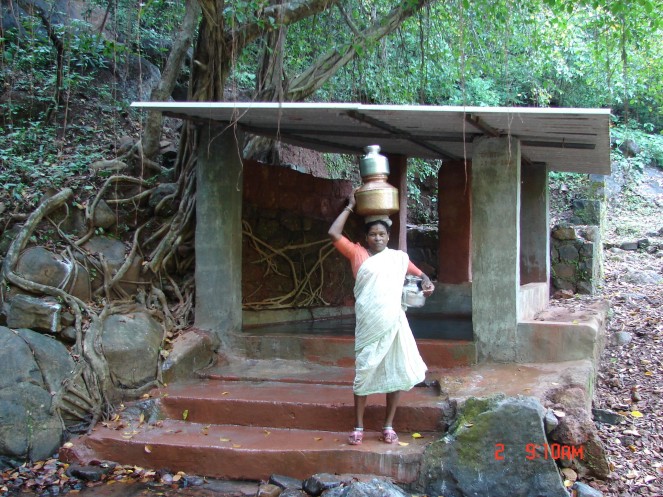 Mountain streams used for drinking water and irrigation (Photo: Author)
Mountain streams used for drinking water and irrigation (Photo: Author)
Surendra Thakurdesai is a Professor of Geology in Gogate Jogalekar College of Ratnagiri and is also a hands-on farmer. He has spearheaded a river rejuvenation program for Golap River in Ratnagiri. Prof Thakurdesai says: “The topography and geology of Konkan makes large dams unviable. Canals networks are very costly due to undulating terrain and porous basalt. We need to accept the productivity limitations of the lateritic, light soil of Konkan. There is no logic behind costly projects in such a situation. On the other hand, whatever limited fertile land that Konkan has in its narrow valleys, is being submerged under the dams. There is not a single Large Project, or even a Medium project, that is serving the people of Konkan to a significant extent.”
“Unlike rest of Maharashtra, agriculture in Konkan is dispersed and on hills. This region cannot be serviced by large dams and canal network. Groundwater, hills streams and rivulets are the lifelines of farmers here and they need to be rejuvenated.”
“The large dams ongoing in Konkan are not for us. They are for the contractors and engineers and lobbies who can afford to buy thousands of acres of land in backwaters of dams like Tillari.”
Dr. Prasad Deodhar who leads an Organisation called Bhagirath in Sindhudurg, amidst all the dam development is also clear, “Konkan needs irrigation no doubt but large projects are not viable for this region. Minor irrigation tanks, small scale structures and groundwater hold a great promise in irrigating hinterlands and are already doing so.”
 Small Tanks made by villagers for irrigation. Kelen Tank in Ratnagiri (Photo: Author)
Small Tanks made by villagers for irrigation. Kelen Tank in Ratnagiri (Photo: Author)
Dr. Shrirang Kardekar, Balasaheb Sawant Konkan Krishi Vidyapeeth, an agricultural scientist who has also worked extensively on Konkan’s crops as well as water problems states that large projects are simply not meant for Konkan. He has been trying to get this across to the government for many years. “The undulating geography, small plains which immediately run into Western Ghat foothill ranges mean that dams in Konkan have to be very tall and hence very costly. This also makes canals difficult to construct. The few canal networks we have are broken and leaking. In rainy season due to very heavy rainfall, they get clogged with sand. Horticulture in Konkan is practiced on hill slopes and there is no way a canal can reach a mango or cashewnut tree on a hill. What can help are dispersed tanks built on plateaus which can give water to plantations through drip. KT weirs across rivers and smaller dams can help riverside cultivation.”
“See, the problem is Engineers trained in Western Maharashtra come to Konkan and want to implement projects which worked on a flat plateau here in our hills and narrow valleys. This one-size fits-all attitude is a big problem. They put forth impractical solutions and then blame farmers for not lifting water.”
Sanjeev Anerao, an environmentalist and plantation owner says that there are hardly any dams which have canal networks. “Engineers build dams, but do not even acquire land for canals. We have several dams without distribution systems and only irrigation is some backwater lifting. How can tax payer money be spent for this? The river was irrigating much more land than this! On the other hand, minor projects which are actually helping farmers are in a state of disrepair. We need to rejuvenate these than go after huge projects like GadNadi which go on and on.”
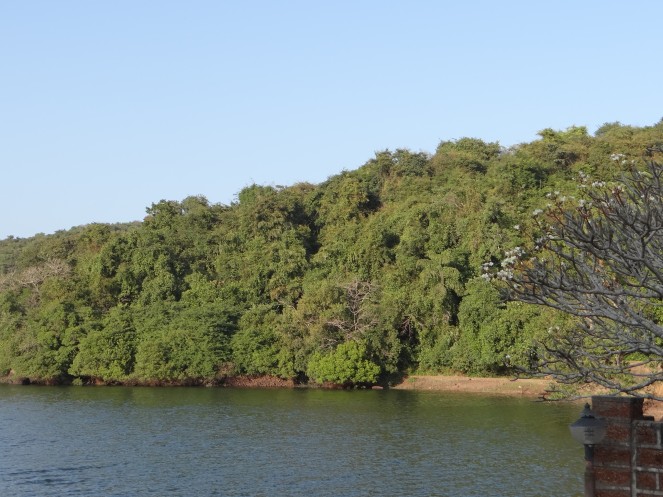 Dhamapur Tank in Sindhudurg District (Photo: Author)
Dhamapur Tank in Sindhudurg District (Photo: Author)
Executive Director, Konkan Irrigation Development Corporation
When I discussed the impasse of non-performing dams with KIDC Executive Director, his approach was positive but he did not have substantial answers to the issues plaguing the region. He talked about the inclusion of private forests in “Forest Lands” requiring clearance and adding to delay, paucity of funds, protests by PAPs as some of the hurdles behind slow development of dams in the region. This does not answer why the projects were started before mandatory Clearances and Rehabilitation in the first place.
He noted “Dams in Konkan are very costly. In the amount it takes to build a medium project on the plateau, we can hardly build a minor project in Konkan.” He agreed that thin spreading of meager funds was one of the reasons behind incomplete projects and asserted that, “This year funds will only be spent on completing canal and distribution networks of projects like Korle Satandi, Devghar and Arjuna.” This is a welcome step.
When I enquired about the best performing Irrigation project in KIDC, he said that there are several projects near Mumbai (Surya, Bhatsa, etc) which were meant to be Irrigation Projects, but are now mostly supplying drinking water to Mumbai, which perform very well. “But what about Irrigation Projects?” I ask. There is no answer.
When asked about non performance of hydropower projects like Kal Kumbhe, the ED agreed that they are extremely costly, but that “Scrapping them now would be a great loss to the nation”. This is a reflection of the ideological support to large dams and has been causing immense harm to overall development.
~~
Way Ahead
Dhamapur Dam, a small earthen dam in Sindhudurg, was built in the 1600’s. It still irrigates over 100 ha of land, while fulfilling drinking water supply needs of the entire Malvan city. There are several temple tanks in Konkan which store rain water in the monsoon and provide irrigation and drinking water in summer. In Ratnagiri, small mountain streams are channelized to various plantations and irrigate the region throughout the year, while helping groundwater recharge.
The experts and stakeholders I talked with were unanimous in their opinion that Minor projects and groundwater have fared better in meeting irrigation needs of the farmers. They suggest a more nuanced understanding of irrigation needs of Konkan before launching big budget projects.
Suggestions include:
- Assessment of irrigation needs of farming specific to Konkan, based on the existing cropping pattern and actual needs of farmers.
- Regular maintenance of Minor Irrigation Projects and their distribution systems
- Rejuvenation of Temple Tanks as a source of drinking water and irrigation
- Desilting rivers, temple tanks and MI Tanks regularly. Desilting has played an important role in Golap River rejuvenation and has helped irrigation.[xiii]
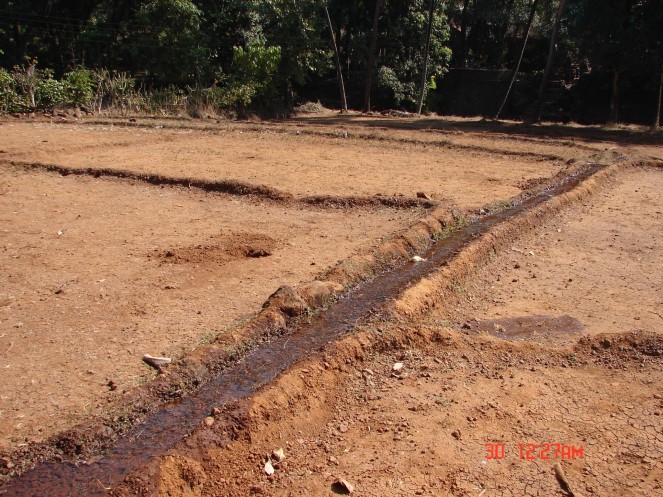 Paat irrigation rejuvenated after desilting Golap River in Ratnagiri (Photo: Author)
Paat irrigation rejuvenated after desilting Golap River in Ratnagiri (Photo: Author)
- Protection of Forests in catchments and hillsides to maintain water levels in streams and wells
- Recharging dug wells by rainwater
- Creating small storages on plateaus (Sadaa in Marathi) to irrigate plantations and fields by drip and gravity, where needed
- Small ferro-cement rainwater harvesting tanks on plateaus and[xiv] villages (Jalvardhini in Sindhudurg) which help significantly in times of need
- Building KT Weirs on large rivers which can store water for a short duration and it can be lifted for irrigation
- Converting open canals into closed conduits/underground pipelines. This was tried in a project in Ratnagiri in 1985-86 and has been successful to a large extent.
- Not allowing Thermal Power Plants/ Chemical industries/ Mining industry to exploit rivers and groundwater or pollute these sources.
- Maharashtra Government’s Flagship Program Jalyukta Shivar holds great promise for this region.
Konkan holds answers to most of its water questions. In such a scenario, large dams are being pushed through by ideological/policy bias, following a uniform development model which does not respect regional difference and strengths, disregarding the ecology and people of the region.
Rampant corruption surrounding dams in Konkan raises big questions about the rationale behind their planning in the first place.
Due to their scope, reports from agencies like CAG or Anti Corruption Bureau cannot conclude about desirability, optimality, necessity or viability for large dams in a particular region. (In fact there is no official agency taking an objective view of these questions!) More important is to look at the holistic viability of projects in Konkan, draw lessons from past mistakes, make necessary course correction, which includes scrapping unviable dam projects like Talamba, Jamada, Virdi, Kal Kumbhe etc.
Like Prof. Thakurdesai says, large dams in Konkan seem to planned more for the welfare of contractors, politicians, engineers, bureaucrats, consultants and plantation mafia than the Konkani people.
Is it not time to look beyond financial corruption and raise questions about basic viability of large dams in biodiversity rich Konkan? Is it not wise to scrap the projects which are stuck once and for all, rather than limping on with them and spending additional crores? Due to investment and resources locked up in large dams, appropriate solutions are being neglected. A region which gets more than 3000 mm rainfall has several small and beautiful solutions up its sleeves, if only we are ready to see.
Parineeta Dandekar, SANDRP, parineeta.dandekar@gmail.com
NOTE: For full PDF file containing this analysis, see: https://sandrp.files.wordpress.com/2015/01/dams_kidc_westernghats_pd-0216.pdf
 Dhamapur Temple Tank in Sindhudurg stands testimony to the power of small structures in Konkan (Photo: Author)
Dhamapur Temple Tank in Sindhudurg stands testimony to the power of small structures in Konkan (Photo: Author)
| Name | District | Year of starting work | Rs Cr spent (Estimate) | Forest & Env Clearance | Status | Remark |
| Surya Major Project | Thane | 1975 | 430 Cr (March 2012) | FC pending for canals.
EC not obtained |
Ongoing | Proposed as an irrigation project for tribals, now water diverted for Mumbai MMRDA |
| Bhatsa Major Project | Thane | 1969 | 463 Cr | FC Partly Pending | Ongoing | Proposed as an irrigation project for tribals, Now water diverted for Mumbai MMRDA |
| Tillari Interstate Project | Sindhudurg | 1986 | 1030 Cr (March 2015) | FC Granted | Ongoing | Opposition by PAPs; Migration routes of Elephants blocked. increasing Man animal conflicts |
| Talamba Major Project | Sindhudurg | 2001 | 142 Cr (March 2015) (1772 Cr) | Application for FC rejected by State Forest Department[i] | Ongoing | Opposed severely by PAPs.
Forest diversion Proposal rejected by Forest Department |
| Deharji Med Project | Thane | 177 Cr (546 Cr) | No Final FC. | Ongoing | 445 hectares to be submerged. | |
| Gadnadi Med Project | Ratnagiri | 1994 | 743 Cr (966 Cr) | Not needed | Ongoing | Opposed severely by PAPs, 700 + hectares submergence. Not even 1/4th Irrigation potential created. |
| Jamada Med Project | Rajapur Ratnagiri | 2004 | 317 Cr, Estimate cost 515 Cr | Not needed | Ongoing | No Irrigation potential created in 10 years; Over 3000 people affected; Joint surveys of their lands have not been completed; Of the 733 ha required, only 44 ha acquired so far[ii], but expenditure is more than Rs 300 Cr! The riverside land to be submerged is fertile and very productive with plantations. |
| Arjuna Med Project | Rajapur,
Ratnagiri |
2003 | 497 Cr
(1054 Cr) |
Not needed | Ongoing | Irrigation Potential 9400 ha;
Created: 868 ha; Rehabilitation not complete[iii] PAPs protesting |
| Korle Satandi Med Project | Devgad Sindhudurga | 2004 | 158 Cr;
381 Cr estimated |
Cleared | Ongoing | IP 3625 ha Created 1027 ha.
Right and left Flank of embankment of Dam collapsed in 2007 and 2008 even before the dam started functioning[iv] |
| Devghar Med Project
|
Shivganga River. Kankavli, Sindhudurg | 1987 | 250 Cr
Estimate 566 Cr |
Not needed | On going | Rehabilitation incomplete. 5000 people affected. Ongoing protests of Dalits and scheduled tribes. The riverside has canal system, sugarcane grown in plenty. Fertile zone which will go under submergence[v]. |
| Aruna Med Project | Vaibhav vadi, Sindhudurg | 2006 | 384 Cr;
Estimate:810 Cr |
Not needed | Ongoing | Nearly 5000 people to be displaced; IP 9400 ha/ IP created: 0; 715 ha to be acquired, 410 acquired. |
| Nardave Med project | Kankavli, Sindhudurg | 2001 | 325 Cr; (825 Cr) | No Final FC
No Env Clearance |
Ongoing | Opposed by affected. About 4000 people to be displaced; IP 12,530 ha, Created: 1100 ha |
| Sarambala Med Project | Sawantwadi-Sindhudurg | 2006 | 69 Cr (428 Cr) | No final FC, No Wildlife Clearance
No EC |
Ongoing | Severe opposition. Case filed in Bombay HC; IP 11,142 hectares; Created: 0 |
| Shirshinge Minor Project | Terekhol River,
Sawantwadi, Sindhudurg |
1999 | 99 Cr; Estimate:
386 Cr |
No FC, | Ongoing | Severe Opposition by PAPS.
Of total 500 hectares land to be acquired, only 128 hectares acquired so far |
END NOTES:
[i]http://www.konkantoday.com/index.php?option=com_content&view=article&id=36712:2014-08-19-06-37-47&catid=147:sindhudurg&Itemid=692
[ii]http://timesofindia.indiatimes.com/city/mumbai/Irrigation-scam-Maharashtra-govt-denies-neta-nexus-blames-dam-delays-on-rehabilitation/articleshow/17683918.cms
[iii] http://www.tarunbharat.com/?p=119898
[iv] http://agmaha.nic.in/Audit%20Reports/Pr_Aud_mum/2013-14/3of2014.pdf
[v]http://prahaar.in/maharashtra/kokanachamewa/246599, http://online3.esakal.com/NewsDetails.aspx?NewsId=4830851441360986825&SectionId=16&SectionName=कोकण&NewsDate=20150601&Provider=-
[vi] http://archive.loksatta.com/index.php?option=com_content&view=article&id=240323:2012-07-26-19-32-06&Itemid=1
[vii]http://www.esakal.com/NewsDetails.aspx?NewsId=5211220018734474476&SectionId=16&SectionName=कोकण&NewsDate=20120927&NewsTitle=शिरशिंगे%20धरणाला%20गरज%20160%20कोटींची
[i] http://saiindia.gov.in/sites/default/files/audit_report_files/Maharashtra_Civil_2010_Chapter_2.pdf
[ii] These projects include Kondhane, Kalu, Shai, Balganga, GadNadi, Gadgadi, Jamda, Chanera, Kal Kumbhe, Shill, Shirshinge, Suseri
[iii] http://www.dnaindia.com/mumbai/report-anti-corruption-bureau-probes-12-dam-projects-in-raigad-maharashtra-government-tells-bombay-high-court-2056641
[iv] http://www.dnaindia.com/mumbai/report-more-trouble-in-store-for-ncp-bjp-minister-2173273
[v] http://saiindia.gov.in/sites/default/files/audit_report_files/Maharashtra_Civil_2010_Chapter_2.pdf
[vi] http://agmaha.nic.in/Audit%20Reports/Pr_Aud_mum/2013-14/3of2014.pdf
[vii] http://articles.economictimes.indiatimes.com/2013-04-16/news/38586488_1_irrigation-projects-cag-affidavit
[viii] This includes parts of Puas, Lerli, Adeli, Digas, Tongewadi, Oros, Pawshi, Kudal to name a few.
[ix] http://timesofindia.indiatimes.com/city/goa/Maharashtra-to-tribunal-Wont-start-work-on-Virdi-dam/articleshow/47181101.cms
[x] https://wrd.maharashtra.gov.in/niku/nu#action:mw_prj_lst
[xi]http://environmentclearance.nic.in/writereaddata/Form-1A/Minutes/28_Final%20Minutes%20of%2058th%20Meeting%20-1st%20-%202nd%20June,%202012.pdf
[xii]http://timesofindia.indiatimes.com/city/mumbai/Irrigation-scam-Maharashtra-govt-denies-neta-nexus-blames-dam-delays-on-rehabilitation/articleshow/17683918.cms
[xiii] http://www.indiawaterportal.org/articles/golap-river-restoration-project-ratnagiri-executed-gogate-joglekar-college-ratnagiri-and
[xiv] http://www.bhagirathgram.org/gallery.html#gallary69
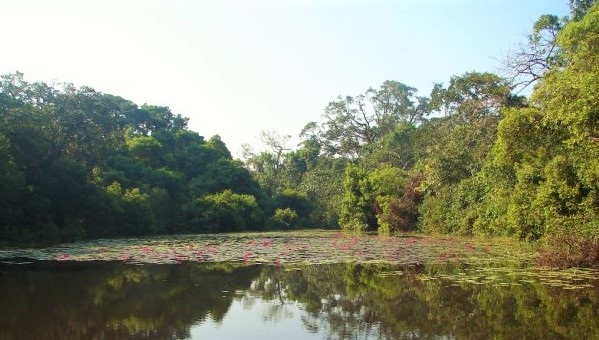
My village Talvat Khed in Ratnagiri District was started 11 years back still unfinished its just a mud bandhara with no pitching with standing water for past 4 years the whole village is dirrectly in front of the dam wall no acquisition of land for canal has been made and the village and its occupants have undergone immense misery this needs to be dealt with either come it or give back our lands I would like to take up this issue please guide me. Vijaya k palande talvar khed
LikeLike
Thanks a lot Madame, thats a bad situation and a huge issue. You can directly contact Executive Director of KIDC Mr. Ansari. The Phone Number of KIDC, Thane is: 022-25329776 or 25329766. Please let us know how it goes.
My email is given above. Let me know if you need any help.
We have published an article on this in Marathi: http://epaper.mimarathilive.com/story.aspx?id=2039&boxid=159912928&ed_date=2016-2-19&ed_code=820009&ed_page=8
warm regards,
parineeta
LikeLike
Dear Sir
I have read your article and i find it quite disturbing on the state of affairs in the konkan area.
I would like to point out a few things in regards to Virdi dam.
1) There is no forest area designated in virdi, as the village has been notified time and again as non- forested. This fact can be proven at the forest department in dodamarg and orus.
2) Yes a small percentage of land has been used for rubber cultivation, please understand that majority of the crop in this area is cashew. As far as analyzing the shrub or tree growth in the non crop area, it consists primarily of non forest grade trees(less than 18″ girth) and shrubs. The land has been in this condition for the majority part of the 20th century on wards. The cashew trees have been here for more than 40 years.
3) Being a hilly area the shortage of water in the parched months is quite severe, for which this dam is going to be a boon. The dispute with Goa has been a severe dent in any further development of this area.
I would request from mediums like yours to come out with the actual facts and numbers and clear all fallacies surrounding this project.
We are very disturbed by the lack of water and callous attitude of the administration in regards towards small farmers like us.
LikeLike